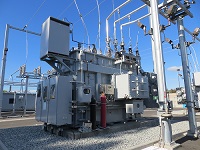


- Power cut-off
- Spread of fire to immediate environment
- Toxic smoke
poisoning of residents
- Non-biodegradable and polluting oil leaks on public roads or common areas
-
Even worse
However, electrical transformers are present everywhere in our daily life: at power stations outlets, at
electrical interconnections, on the outskirts of cities, in every neighborhood, each plant and large building
for the terminal distribution of electricity.
Look carefully, you’ve got to have one on your street or on
your block.
All these transformers are filled with oil of variable quality (we will come back to this).
Some measures are being taken to limit the consequences of transformer fires, particularly in factories or in urban areas, such as the introduction of minimum distances from buildings, the installation of firewall walls, anti-dumping retention pits or automatic extinguishing systems, especially for transformers installed in buildings.
These measures are standardized internationally, by IEC (International Electrotechnical Commission) standards, such as IEC 61936*, or in France by NF standards, such as NF C13-200** for electrical stations. Many guides are also published for electrical installers by professional organizations.

Some measurements do exist, but there is no published systematic count.
These figures vary greatly from one country to another, depending on the state of the electricity grid and external constraints, particularly climatic ones.
You have to investigate to find an assessment of the damage done by transformer fires.
International bodies, such as CIGRE (Conseil International des Grands Réseaux Electriques), give statistics on the number of fires according to the types of transformers:Of these 5500 cases, 192 were considered to have a significant impact: 142 on power transformers, 5 on distribution transformers.
Given that there are about 1000 power transformers in Italy, it can be considered that 14% of these transformers (the largest) suffered a fire with significant consequences over a 10-year period.
In France, reading the regional press shows that not two weeks go by without a significant fire somewhere on the metropolitan territory:
For example, between May 15th and June 16th, 2021:For the record, we estimate that there are approximately 800,000 transformers in service in France.

These transformer fires are caused by the ignition of mineral oil (of petroleum origin), which is used in electrical transformers, for example, because of a significant heating due to an electrical defect.
To properly fulfill their role as insulator in the transformer, mineral oils must be relatively fluid (less than 12 centistokes at 40°C) and therefore have a relatively low flash point***, between 140 and 170°C depending on the oil.They have a fire point of about 160°C. In case of heating above this temperature even on a small part of the insulating oil, a simple spark can cause a tragedy.
In comparison, low flammable insulating fluids (classified K by IEC 60110) have a fire point greater than 300 °C.
This category includes vegetable-based oils or synthetic ester oils.It is important to underline that no fire of transformer filled with low-flammable insulating fluid has been recorded so far, whereas these insulating fluids exist and have been used for more than thirty years.
Some major international insurance companies even require these types of insulating fluid in facilities they consider to be at risk.
An IEC Working Group is currently studying the benefits of these fluids to improve fire safety, but it will take several years for them to reach their conclusions.
* IEC 61936: Power installations exceeding 1 kV AC and 1,5 kV DC
** NF C13-200: High voltage electrical installations - additional rules for production sites and industrial,
commercial and agricultural installations
*** Flash point: lowest temperature at which a liquid can ignite if given an ignition source like fire or a
spark.